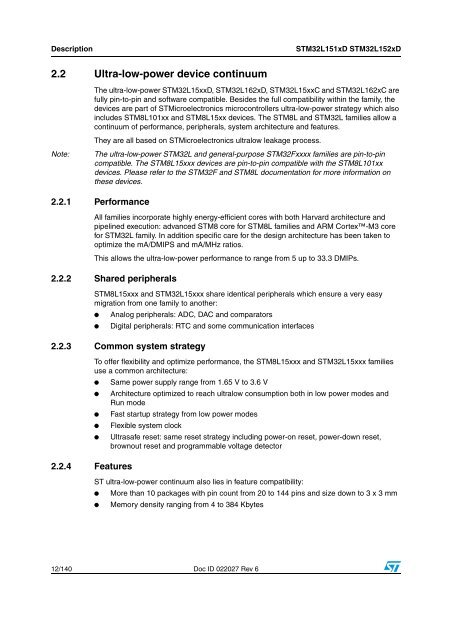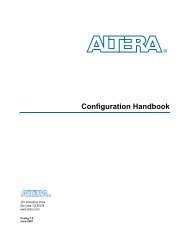Ultra-low-power 32-bit MCU ARM-based Cortex-M3, 384KB ... - Keil
Ultra-low-power 32-bit MCU ARM-based Cortex-M3, 384KB ... - Keil
Ultra-low-power 32-bit MCU ARM-based Cortex-M3, 384KB ... - Keil
Create successful ePaper yourself
Turn your PDF publications into a flip-book with our unique Google optimized e-Paper software.
Description<br />
STM<strong>32</strong>L151xD STM<strong>32</strong>L152xD<br />
2.2 <strong>Ultra</strong>-<strong>low</strong>-<strong>power</strong> device continuum<br />
The ultra-<strong>low</strong>-<strong>power</strong> STM<strong>32</strong>L15xxD, STM<strong>32</strong>L162xD, STM<strong>32</strong>L15xxC and STM<strong>32</strong>L162xC are<br />
fully pin-to-pin and software compatible. Besides the full compatibility within the family, the<br />
devices are part of STMicroelectronics microcontrollers ultra-<strong>low</strong>-<strong>power</strong> strategy which also<br />
includes STM8L101xx and STM8L15xx devices. The STM8L and STM<strong>32</strong>L families al<strong>low</strong> a<br />
continuum of performance, peripherals, system architecture and features.<br />
They are all <strong>based</strong> on STMicroelectronics ultra<strong>low</strong> leakage process.<br />
Note:<br />
The ultra-<strong>low</strong>-<strong>power</strong> STM<strong>32</strong>L and general-purpose STM<strong>32</strong>Fxxxx families are pin-to-pin<br />
compatible. The STM8L15xxx devices are pin-to-pin compatible with the STM8L101xx<br />
devices. Please refer to the STM<strong>32</strong>F and STM8L documentation for more information on<br />
these devices.<br />
2.2.1 Performance<br />
All families incorporate highly energy-efficient cores with both Harvard architecture and<br />
pipelined execution: advanced STM8 core for STM8L families and <strong>ARM</strong> <strong>Cortex</strong>-<strong>M3</strong> core<br />
for STM<strong>32</strong>L family. In addition specific care for the design architecture has been taken to<br />
optimize the mA/DMIPS and mA/MHz ratios.<br />
This al<strong>low</strong>s the ultra-<strong>low</strong>-<strong>power</strong> performance to range from 5 up to 33.3 DMIPs.<br />
2.2.2 Shared peripherals<br />
STM8L15xxx and STM<strong>32</strong>L15xxx share identical peripherals which ensure a very easy<br />
migration from one family to another:<br />
● Analog peripherals: ADC, DAC and comparators<br />
● Digital peripherals: RTC and some communication interfaces<br />
2.2.3 Common system strategy<br />
To offer flexibility and optimize performance, the STM8L15xxx and STM<strong>32</strong>L15xxx families<br />
use a common architecture:<br />
● Same <strong>power</strong> supply range from 1.65 V to 3.6 V<br />
● Architecture optimized to reach ultra<strong>low</strong> consumption both in <strong>low</strong> <strong>power</strong> modes and<br />
Run mode<br />
● Fast startup strategy from <strong>low</strong> <strong>power</strong> modes<br />
● Flexible system clock<br />
● <strong>Ultra</strong>safe reset: same reset strategy including <strong>power</strong>-on reset, <strong>power</strong>-down reset,<br />
brownout reset and programmable voltage detector<br />
2.2.4 Features<br />
ST ultra-<strong>low</strong>-<strong>power</strong> continuum also lies in feature compatibility:<br />
●<br />
●<br />
More than 10 packages with pin count from 20 to 144 pins and size down to 3 x 3 mm<br />
Memory density ranging from 4 to 384 Kbytes<br />
12/140 Doc ID 022027 Rev 6

















